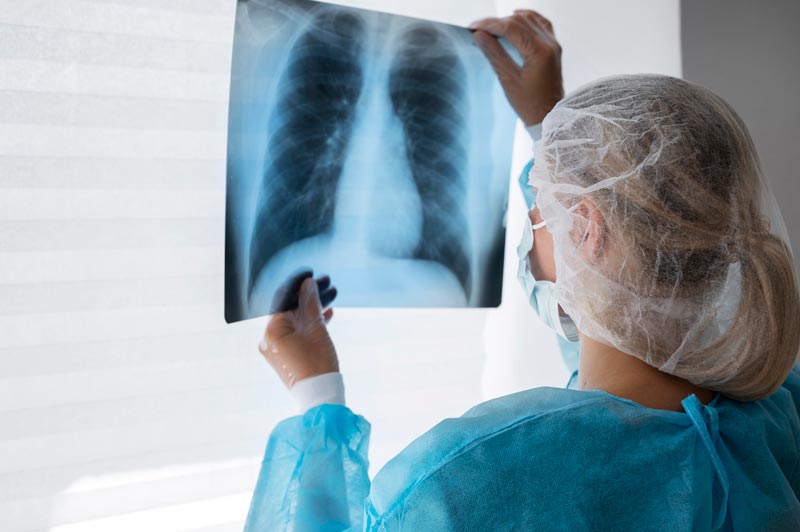
Key Takeaways
Introduction
What is Pneumonia in Children?
8 Care Tips for Children with Pneumonia by Urgent Care in Stamford, CT
8 Warning Signs of Pneumonia in Children
Finding a Reputable Urgent Care in Stamford, CT for Pneumonia
Prevention Strategies for Pneumonia
Frequently Asked Questions
✔ Pneumonia in children is a serious lung infection that requires prompt recognition and treatment.
✔ Urgent care in Stamford, CT, recommends rest, hydration, and medication adherence to help children recover from pneumonia at home.
✔ Recognizing warning signs like persistent cough, difficulty breathing, and high fever can prompt timely medical attention to address pneumonia in children.
✔ It’s crucial to seek urgent care in Stamford, CT, for children with severe respiratory symptoms, high fever, or worsening conditions suggestive of pneumonia or other serious illnesses.
✔ Urgent care in Stamford, CT, emphasizes vaccination, good hygiene practices, and avoiding exposure to respiratory infections as effective strategies to prevent pneumonia and keep children healthy.
Pneumonia is a sickness that affects the lungs and can make children very sick. Parents and caregivers need to know the signs of pneumonia and how to help if a child gets it. Here, we’ll talk about the signs of pneumonia in children and some tips from urgent care in Stamford, CT, on how to take care of them.
Pneumonia is an infection that inflames the air sacs in one or both lungs, leading to cough, fever, and difficulty breathing. In children, pneumonia can range from mild to severe and may require medical intervention depending on the cause and severity.
Pneumonia is an infection that inflames the air sacs in one or both lungs, leading to cough, fever, and difficulty breathing. In children, pneumonia can range from mild to severe and may require medical intervention depending on the cause and severity.
When a child is diagnosed with pneumonia, appropriate care is essential for their recovery and well-being. At urgent care in Stamford, CT, they understand the importance of providing comprehensive support and guidance to parents and caregivers during this challenging time.
Here are some care tips to help manage pneumonia in children:
It’s crucial to adhere to the treatment plan outlined by the healthcare provider at urgent care in Stamford, CT. This may include medications, such as antibiotics for bacterial pneumonia or antiviral drugs for viral pneumonia. Ensure that the child completes the full course of medication as prescribed.
Keep a close eye on the child’s symptoms and condition. If there are any changes or worsening of symptoms, contact urgent care in Stamford, CT, immediately for further guidance. Symptoms to watch out for include persistent fever, difficulty breathing, chest pain, and dehydration.
Rest is vital for the body to heal, so ensure that the child gets plenty of restorative sleep. Additionally, urgent care in Stamford, CT, also suggests encouraging them to drink plenty of fluids to prevent dehydration. Offer water, clear broth, or electrolyte solutions frequently throughout the day.
If the child has a fever, use over-the-counter fever reducers such as acetaminophen or ibuprofen, following the dosing recommendations provided by urgent care in Stamford, CT. Dress them lightly and keep the room temperature comfortable to help reduce fever naturally.
Ease the child’s discomfort by creating a comfortable environment. Use a cool-mist humidifier to moisten the air, which can help alleviate coughing and soothe irritated airways. Provide gentle chest percussion or back patting to help loosen mucus.
Help the child perform deep breathing exercises or use an incentive spirometer if recommended by urgent care in Stamford, CT. This can help keep the airways open and improve lung function.
Teach the child good hygiene practices, such as covering their mouth and nose when coughing or sneezing, and washing hands frequently. This can help prevent the spread of infection to others and reduce the risk of complications.
Schedule a follow-up appointment with urgent care in Stamford, CT, as recommended by the healthcare provider. Regular check-ups are essential to monitor the child’s progress and ensure that they are recovering properly.
While there are plenty of ways to manage pneumonia in children, there are cases where symptoms may persist or worsen over time. Recognizing the warning signs of pneumonia in children is crucial for timely intervention and optimal treatment. Here are some warning signs to watch out for according to urgent care in Stamford, CT:
A cough that persists or worsens over time, especially if it’s accompanied by phlegm or mucus, can be a sign of pneumonia. Pay attention to the frequency and intensity of the cough.
Children with pneumonia may experience difficulty breathing or rapid, shallow breathing. They may also exhibit wheezing or grunting sounds while breathing. Look for signs of chest retractions, where the skin between the ribs pulls in with each breath.
A fever is a common symptom of pneumonia in children. Monitor the child’s temperature regularly and seek medical attention if it rises above a certain threshold, especially if it persists despite fever-reducing medication.
Pneumonia can cause fatigue and lethargy in children, leading to decreased activity levels and increased sleepiness. On the other hand, some children may become more irritable or fussy than usual.
Loss of appetite or refusal to eat can indicate illness in children, including pneumonia. Pay attention to changes in the child’s eating habits and overall intake of fluids and food.
In severe cases of pneumonia, children may develop cyanosis, characterized by a bluish discoloration of the lips, nails, or skin. This indicates a lack of oxygen in the blood and requires immediate medical attention.
Older children may complain of chest pain or discomfort, especially when breathing deeply or coughing. This can be due to inflammation of the lung tissue or irritation of the chest wall.
Severe pneumonia can lead to lethargy, confusion, or altered mental status in children. They may appear unusually drowsy, unresponsive, or disoriented.

When you or a loved one requires urgent medical attention, finding a reputable urgent care center becomes a top priority. Here’s a comprehensive guide to help you navigate through the process of finding a reputable urgent care in Stamford, CT.
Start your search by exploring urgent care facilities in Stamford online. Websites like Yelp, Google Maps, and Healthgrades offer reviews and ratings from patients who have visited these centers. Look for facilities with consistently positive reviews and high ratings, as they often indicate quality service and patient satisfaction.
Verify that the urgent care in Stamford, CT, you’re considering is accredited and licensed to operate in Connecticut. Accreditation from organizations like the Urgent Care Association (UCA) ensures that the facility meets high standards of care and safety. Additionally, the healthcare providers at the center should be licensed professionals with the necessary qualifications and experience.
Consider the range of services provided by the urgent care in Stamford, CT. A reputable facility should offer various medical services, including treatment for common illnesses and injuries, diagnostic tests, vaccinations, and basic preventive care. Ensure that the center can address your specific healthcare needs effectively.
Take into account the amenities and facilities available at the urgent care in Stamford, CT. A well-equipped facility with modern medical technology and on-site laboratory and imaging services can facilitate prompt and accurate diagnosis and treatment. Clean and comfortable waiting areas and exam rooms contribute to a positive patient experience.
Check whether the urgent care in Stamford, CT, accepts your health insurance plan. Most reputable facilities work with various insurance providers to make healthcare services more accessible and affordable for patients. Confirming insurance acceptance in advance can help you avoid unexpected out-of-pocket expenses.
Choose an urgent care in Stamford, CT, that is conveniently located and easily accessible from your home, workplace, or school. Proximity to public transportation and ample parking facilities can further enhance accessibility, especially during emergencies. Opting for a centrally located facility saves time and ensures prompt medical attention when every minute counts.
Ask friends, family members, and healthcare professionals for recommendations on reputable urgent care centers in Stamford. Personal referrals from individuals you trust can provide valuable insights into the quality of care and patient experience at different facilities.
Pneumonia, a serious respiratory infection, poses a significant health risk, particularly for vulnerable populations. However, proactive prevention strategies can help reduce the incidence and severity of pneumonia cases.
Here are insights into the prevention strategies recommended by urgent care in Stamford, CT:
Vaccination is one of the most effective ways to prevent pneumonia and other respiratory infections in children. Ensure that your child receives all recommended vaccines, including those for influenza (flu), pneumococcal disease, and pertussis (whooping cough). Urgent care in Stamford, CT, offers vaccination services to help protect children against vaccine-preventable diseases.
Community education and awareness initiatives empower individuals with knowledge about pneumonia prevention. Through informative seminars, workshops, and outreach events, healthcare professionals educate patients about the importance of good respiratory hygiene, smoking cessation, and maintaining a healthy lifestyle to reduce the risk of pneumonia.
Early detection and treatment of respiratory infections are essential in preventing pneumonia complications. Urgent care in Stamford, CT, offers timely evaluation and management of respiratory symptoms, such as cough, fever, and difficulty breathing. By providing rapid diagnostic testing, including chest X-rays and laboratory analyses, these facilities ensure prompt identification of pneumonia cases.
Pneumonia caused by certain infectious agents like bacteria or viruses can indeed be contagious. When a child with pneumonia coughs or sneezes, tiny droplets containing the infectious agents can be expelled into the air, potentially infecting others. Close contact with an infected person or touching surfaces contaminated with respiratory droplets can also spread the infection.
The recovery time for pneumonia in children can vary based on factors such as the severity of the illness, the child’s overall health, and how promptly treatment is initiated. In many cases, children will start to show improvement within a few days of starting treatment, with symptoms such as fever and cough gradually subsiding.
It’s best to keep a child with pneumonia at home until they are no longer contagious and their symptoms have significantly improved. Sending a child with pneumonia to school or daycare while they are still contagious not only puts other children at risk of getting sick but also prolongs the child’s own recovery.
It’s possible for children to develop pneumonia multiple times, especially if they have underlying health conditions that compromise their immune system or respiratory function. Additionally, exposure to respiratory pathogens in environments such as daycare centers, schools, or crowded living conditions can increase the risk of recurrent infections. To reduce the likelihood of recurrent pneumonia, it’s important to focus on preventive measures such as vaccination, good hygiene practices, and minimizing exposure to sick individuals.
Using a nebulizer can be beneficial for treating pneumonia, especially in cases where the child is having difficulty breathing or is unable to take oral medications. Nebulizers deliver medication directly to the lungs in the form of a mist, which can help to open up airways, reduce inflammation, and alleviate symptoms such as coughing and shortness of breath. Common medications used in nebulizers for pneumonia treatment include bronchodilators to help widen the airways and corticosteroids to reduce inflammation.

When it comes to your child’s health, vigilance is key. Stay informed about pneumonia warning signs and essential care tips with DOCS Urgent Care Stamford. Our pediatric specialists are here to provide expert guidance and support, ensuring your child receives the best possible care. From early detection to personalized treatment plans, trust our team to safeguard your child’s well-being. Contact us today to schedule an appointment and learn more about how we can help you protect your child against pneumonia.



During this surge in COVID-19 cases, our primary focus is meeting the high demand for tests, and we are seeing higher than usual wait times. This means we are unable to answer most phone calls. Please know that our teams are working very hard during this time to care for as many patients as safely as possible. Please click the button below for answers to common questions. We appreciate your understanding.